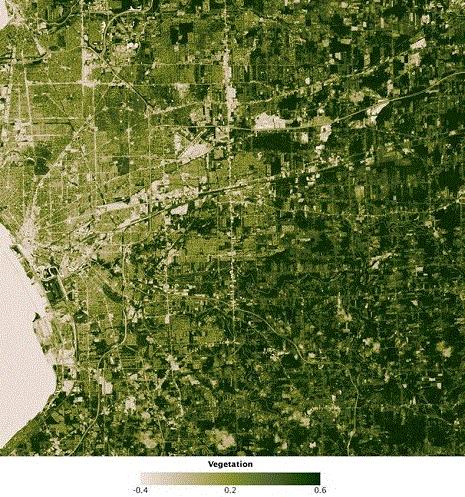Vegetation Protective of Women's Health
Vegetation Protective of Women's Health
By Debbie Hamrick and Ball Publishing.

By Debbie Hamrick and Ball Publishing.
Living
in green is good for women's health; the more vegetation the better.
Photo: NASA.
It’s official: Women should surround themselves with vegetation. Go hug a tree, roll in the grass, play in the dirt planting and take a walk in the park. The results of an eight-year study showed that women living in areas with more vegetation had a 12% lower mortality rate than women living in areas with the least vegetation.
Maximizing health outcomes is the ultimate functional landscape. U.S. women living in the areas that have the most vegetation around their homes have lower mortality than those living in areas with the least green. It didn’t matter where the green exposure was: city or country, east or west, north or south.
“We observed no threshold at which greater greenness was not associated with lower mortality rates,” the authors wrote. The main benefits were improved mental health, social connections, exercise and lower air pollution. “Green vegetation has a protective effect …”
The message is clear to politicians, city planners, engineers, landscape architects, utilities, highway departments and others who determine what the managed space should look like: Increase vegetation, and directly and proportionally lower mortality rates. Plus, you can manage stormwater, sequester carbon, cool the air, provide wildlife habitat and increase property values. Plants and vegetation - they’re a win-win for everyone.
More exposure to vegetation linked with lower mortality rates in women Harvard T.H. Chan School of Public Health. Exposure to Greenness and Mortality in a Nationwide Prospective Cohort Study of Women by Peter James, Jaime E. Hart, Rachel F. Banay, and Francine Laden in Environmental Health Perspectives DOI:10.1289/ehp.1510363.
Maximizing health outcomes is the ultimate functional landscape. U.S. women living in the areas that have the most vegetation around their homes have lower mortality than those living in areas with the least green. It didn’t matter where the green exposure was: city or country, east or west, north or south.
“We observed no threshold at which greater greenness was not associated with lower mortality rates,” the authors wrote. The main benefits were improved mental health, social connections, exercise and lower air pollution. “Green vegetation has a protective effect …”
The message is clear to politicians, city planners, engineers, landscape architects, utilities, highway departments and others who determine what the managed space should look like: Increase vegetation, and directly and proportionally lower mortality rates. Plus, you can manage stormwater, sequester carbon, cool the air, provide wildlife habitat and increase property values. Plants and vegetation - they’re a win-win for everyone.
More exposure to vegetation linked with lower mortality rates in women Harvard T.H. Chan School of Public Health. Exposure to Greenness and Mortality in a Nationwide Prospective Cohort Study of Women by Peter James, Jaime E. Hart, Rachel F. Banay, and Francine Laden in Environmental Health Perspectives DOI:10.1289/ehp.1510363.



